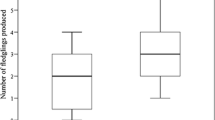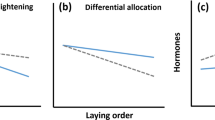Summary
The importance of food availability as a constraint upon cooperative behaviour was examined by providing supplementary food on some breeding territories of a population of moorhens (Gallinula chloropus). First brood juveniles on territories provided with food were more likely to feed their younger second brood siblings. Supplementary feeding improved the physical condition of juveniles above that of unfed conspecifics, and birds in better condition were more likely to be helpers. Helpers on fed territories also provided more food to siblings than did their counterparts on unfed territories, enabling parent birds to reduce their work rates. Results are discussed in relation to the benefits which may accrue to helpers and the energetic costs of cooperation which may act as proximate constraints upon potential helpers.
Similar content being viewed by others
References
Brown JL (1974) Alternate routes to sociality in jays — with a theory for the evolution of altruism and communal breeding. Am Zool 14:63–80
Brown JL (1978) Avian communal breeding systems. Ann Rev Ecol Syst 9:123–155
Brown JL (1982) Optimal group size in territorial animals. J Theor Biol 95:793–810
Chase ID (1980) Cooperative and noncooperative behaviour in animals. Am Nat 115:827–857
Emlen ST (1982a) The evolution of helping I. An ecological constraints model. Am Nat 119:29–39
Emlen ST (1982b) The evolution of helping II. The role of behavioural conflict. Am Nat 119:40–53
Emlen ST, Vehrencamp SL (1983) Cooperative breeding strategies among birds. In: Brush AH, Clark GA Jr (eds) Perspectives in ornithology: Essays presented for the Centennial of the American Ornithologists. Cambridge University Press, Cambridge
Gibbons DW (1987) Juvenile helping in the moorhen Gallinula chloropus. Anim Behav 35:170–181
Koenig WD, Pitelka FA (1981) Ecological factors and kin selection in the evolution of cooperative breeding in birds. In: Alexander RD, Tinkle DW (eds) Natural selection and social behaviour. Chiron Press/Blackwells, Oxford
Orians GH, Orians CE, Orians KJ (1977) Helpers at the nest in some Argentine blackbirds. In: Stonehouse B, Perrins CM (eds) Evolutionary ecology. Macmillan Press, London
Petrie M (1983) Female moorhens compete for small fat males. Science 220:413–415
Reyer HU (1984) Investment and relatedness: a cost/benefit analysis of breeding and helping in the pied kingfisher (Ceryle rudis). Anim Behav 32:1163–1178
Reyer HU, Westerterp KR (1985) Parental energyexpenditure: a proximate cause of helper recruitment in the pied kingfisher (Ceryle rudis). Behav Ecol Sociobiol 17:363–369
Rowley I (1965) The life history of the superb blue wren Malurus cyaneus. Emu 64:251–297
Stallcup JA, Woolfenden GE (1978) Family status and contributions to breeding by Florida serub jays. Anim Behav 26:1144–1156
Woolfenden GE, Fitzpatrick JW (1984) The Florida Scrub Jay: Demography of a cooperative breeding bird, Princeton University Press, Princeton, NJ
Author information
Authors and Affiliations
Rights and permissions
About this article
Cite this article
Eden, S.F. When do helpers help? Food availability and helping in the moorhen, Gallinula chloropus . Behav Ecol Sociobiol 21, 191–195 (1987). https://doi.org/10.1007/BF00303210
Received:
Accepted:
Issue Date:
DOI: https://doi.org/10.1007/BF00303210




